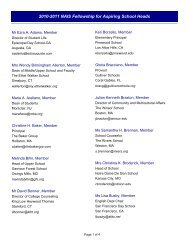History of NAIS from the Nineties to the New Millennium
History of NAIS from the Nineties to the New Millennium
History of NAIS from the Nineties to the New Millennium
Create successful ePaper yourself
Turn your PDF publications into a flip-book with our unique Google optimized e-Paper software.
All <strong>NAIS</strong> vice presidents and direc<strong>to</strong>rs became <strong>to</strong>tally conversant with <strong>the</strong> realities and<br />
potential <strong>of</strong> <strong>the</strong> modern technologies. Donna Orem’s work in curriculum and<br />
governance, Hea<strong>the</strong>r Hoerle’s marketing initiatives, Jefferson Burnett’s Public Affairs<br />
Leadership Network, Margaret Goldsborough’s and Nancy Raley’s communications and<br />
media services, Mark Mitchell’s financial aid services, Gene Batiste’s equity and justice<br />
initiatives, Claudia Gallant’s pr<strong>of</strong>essional development opportunities, Martha Galindo’s<br />
research – all became available on <strong>the</strong> <strong>NAIS</strong> website with links <strong>to</strong> endless o<strong>the</strong>r<br />
resources.<br />
Print remained important. All <strong>the</strong> books mentioned here continued <strong>to</strong> be marketed<br />
vigorously, and packets went out <strong>to</strong> schools, prospective members, <strong>the</strong> media, and <strong>the</strong><br />
public in ever-increasing numbers. One packet alone <strong>from</strong> Selby Holmberg McPhee’s<br />
promoting independent education <strong>of</strong>fice contained several components: <strong>NAIS</strong> statistics; a<br />
detailed statement on <strong>NAIS</strong> accountability <strong>to</strong> parents, students, alumni, government, and<br />
accrediting agencies; <strong>the</strong> <strong>NAIS</strong> Executive Summary featuring legal issues and legislative<br />
and regula<strong>to</strong>ry updates; a summary <strong>of</strong> Leadership through Partnership; a preview <strong>of</strong> <strong>the</strong><br />
Annual Conference; online book ordering instructions; <strong>the</strong> new Global Perspectives; and<br />
a book mark. As I recall, Selby and her staff had a dozen more ideas, but you have <strong>to</strong><br />
s<strong>to</strong>p somewhere.<br />
My final year at <strong>NAIS</strong> was a busy time for looking ahead, creating a new strategic plan<br />
for <strong>the</strong> next five years and beyond. I doubt that it would be helpful <strong>to</strong> review <strong>the</strong> plan;<br />
better just <strong>to</strong> see what has been done, what has changed and improved since I left as<br />
president <strong>of</strong> <strong>NAIS</strong>. The process was important, because more than 100 leaders met <strong>to</strong><br />
create <strong>the</strong> plan, hundreds more had direct input, and thousands <strong>of</strong> people responded <strong>to</strong><br />
surveys. But <strong>the</strong> pro<strong>of</strong> <strong>of</strong> <strong>the</strong> importance and validity <strong>of</strong> <strong>the</strong> plan is what has transpired<br />
since Pat Bassett became president. If you do try <strong>to</strong> bridge 1991-2001 <strong>to</strong> <strong>to</strong>day’s<br />
activities, I trust you will also be aware <strong>of</strong> <strong>the</strong> his<strong>to</strong>rical continuum <strong>of</strong> <strong>NAIS</strong>. As I<br />
mentioned at <strong>the</strong> outset, please read John Esty’s article on his time as president. And<br />
read Cary Potter, <strong>to</strong>o. President <strong>of</strong> <strong>NAIS</strong> <strong>from</strong> 1964 <strong>to</strong> 1978, Cary wrote a marvelous<br />
early his<strong>to</strong>ry for <strong>the</strong> fall 1987 issue <strong>of</strong> Independent School, entitled "<strong>NAIS</strong>: Twenty Five<br />
or Sixty-Two?"<br />
I called it a career in 2001, not only at <strong>NAIS</strong> but ending more than 40 years in schools<br />
and school districts and reporting <strong>to</strong> boards and government service. There was<br />
symmetry <strong>to</strong> it all – 10 years at Hawken School <strong>to</strong> begin my career in education, 10 years<br />
at <strong>the</strong> end with <strong>NAIS</strong>. Besides, wasn’t I really keeping my word <strong>to</strong> John Ratté, perhaps<br />
prescient in 1991, by getting me <strong>to</strong> predict that I had 10 years at <strong>NAIS</strong> <strong>to</strong> accomplish a<br />
few things?<br />
What retirement has meant, having a fine time continuing <strong>to</strong> work with schools in <strong>the</strong><br />
U.S. and around <strong>the</strong> world, is an extension <strong>of</strong> <strong>NAIS</strong>’s commitment. In <strong>the</strong> academic year<br />
2005-06, I was visiting scholar at ASSETS in Honolulu for Lou Salza, at German<strong>to</strong>wn<br />
Academy in Philadelphia for Jim Connor, at Hawken in Cleveland for Jim Berkman, and<br />
as I finish this retrospective I’m preparing <strong>to</strong> leave for China with my wife, Mary Jo, <strong>to</strong><br />
be scholar-in-residence at <strong>the</strong> Shanghai American School for Dennis Larkin.




